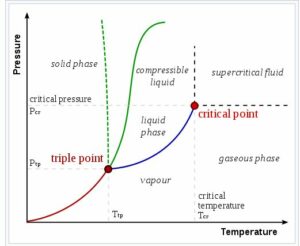If we consider the phase diagram of a pure substance such as that of water, the Saturated Liquid water Line and Saturated Vapor Line divide the whole phase diagram into three distinct regions.
A pure substance undergoes state changes as per the variation in temperature, pressure, and volume of the substance. The solid line which separates compressed or sub-cooled liquid from the saturated mixture of vapor and liquid is known as Saturated Liquid Line.
The saturated liquid line denotes the phase change of a substance from liquid to vapor. Below the saturated liquid line, the substance is in pure liquid form, and above it is in partial vapor form till enough heat is added to convert it to 100% vapor.
For a laymen water boils at 100 °C and hence the water is considered saturated at that temperature. The above statement would hold true when water is being heated at atmospheric pressure at sea level. However, if water is heated at a higher elevation (like in a mountain top) or in an enclosed pressurized enclosure (like in a boiler), it would start boiling at different temperatures. In other words, water attains saturation state at different temperatures at different system pressures. Thus, a combination of various temperature and pressure values at which water exists in its saturated form defines the saturated liquid line for water.
Properties of Saturated Liquid Water
If water exists in its liquid state at its saturation temperature and pressure, it is known as a saturated liquid or saturated liquid water.
Water or, for that matter, any liquid tends to lose its saturation state as its temperature is increased or its pressure decreases.
Saturated liquid water is defined by a thermodynamic state specified by its temperature and pressure sets. Water exists in a saturated liquid state from temperatures ranging from 0 deg C to 374 deg C with corresponding Saturation pressures ranging from 0.006 bar to 200.9 bar. At temperatures beyond 374 deg C or pressures beyond 200.9 bar, water exits in both liquid as well as vapor form. These temperature and pressure numbers define what is called the Critical point of liquid water.
On the other hand, at a temperature below 0 deg C, water exists either as solid ice or coexists as a mixture of liquid water and solid ice.
Saturated water becomes sub-cooled as pressure is increased beyond its saturated state. The different states of water are shown by in the following graph:

The Density of Saturated Liquid Water
If we consider compressible fluid like gases, the density increase with the decrease in temperature and increase in pressure. The liquid is termed an incompressible fluid, so the impact of pressure in densities is minimal, but the temperature does have some impact.
To keep liquid water in a saturated state as the temperature is increased, pressure must be increased. Thus, although minimal, the impact of the decrease in density due to the rise in temperature is partly countered by an increase in respective saturation pressure.
Saturated liquid water at 0.01 deg C has a density of 999.79 kg/m3. The corresponding pressure is 0.006 bar. At a temperature of 100 deg C, the density is 958 kg/m3. The corresponding pressure is 101.42 bar. This indicates as the temperature is increased, saturated liquid water densities too decrease.
Enthalpy of Saturated Liquid Water
Enthalpy is the sum of internal energy and PV work done.
The internal energy of a compound is dependent on its temperature and so its Enthalpy.
If the temperature of a substance increases, the kinetic energy of the molecules also increase resulting in an increase in its internal energy. The PV work done with increased temperature is nil. Thus,the overall enthalpy impact with an increase in temperature is the same as the impact on internal energy with increased temperature.
Saturated Liquid Water Table
The saturated liquid water table includes temperature and pressure set points at which water exists in a saturated liquid state.
By saturated liquid state, it implies that the addition of a small amount of heat to it would lead to vaporization of water. A standard saturation table for water represents the density, Enthalpy, entropy, and specific volume at the corresponding temperature and pressure values.
The saturated liquid water table starts with a temperature of 0.01 °C with corresponding saturation pressure of 611 MPa or 0.006 bar. The corresponding Enthalpy is 2500.9 Kj/kg, and entropy is 9.1555 KJ/Kg.K, density is 999.79, and specific volume of 1.00021 m3/Kg.
As the temperature increases in the saturated water table, the corresponding pressure increase to keep water in a saturated liquid state. With the rise in temperature, the density decreases and also there is an increase in its specific volume. The Enthalpy increases due to an increase in internal energy, while on the other hand, the entropy decreases.
These tables can be generated via software such as WASP® and online calculators such as one available at https://www.spiraxsarco.com/resources-and-design-tools/steam-tables/saturated-water-line for various temperatures. Saturated water tables are also available at sites such as https://www.cambridge.org/br/files/9813/6697/5550/Appendix_B.pdf.

I am Sangeeta Das. I have completed my Masters in Mechanical Engineering with specialization in I.C Engine and Automobiles. I have around ten years of experience encompassing industry and academia. My area of interest includes I.C. Engines, Aerodynamics and Fluid Mechanics. You can reach me at